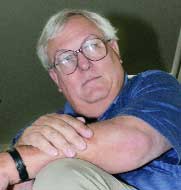Survival Guide: John Stenbit, former Defense Department's chief information officer

John Stenbit's name is synonymous with network-centricity. As the Defense Department's chief information officer, Stenbit's job was to come up with the technology programs that would transform the military into a data-driven enterprise.
John Stenbit's name is synonymous with network-centricity. As the Defense Department's chief information officer, Stenbit's job was to come up with the technology programs that would transform the military into a data-driven enterprise. The Global Information Grid Bandwidth Expansion, Joint Tactical Radio System and Transformational Communications Satellite programs are a few of the initiatives he helped launch.Stenbit resigned in March and is serving on the boards of McDonald Bradley Inc. and SI International Inc. He's also consulting for industry and working with various government advisory boards. Where does he relax? On a family farm in Holland. Having recently returned from vacation abroad, Stenbit spoke to Staff Writer Brad Grimes about life after the Defense Department.WT: You just completed your second stint with the Defense Department, and you previously spent years as an executive with TRW Inc. (now part of Northrop Grumman Corp.). What makes a successful IT executive take a job in government?Stenbit: If you're in the industry as a government contractor, my view is you owe it to the government. If you're committed to doing things to support the government and they ask you to support it directly, I think you have to say yes.WT: Dawn Meyerriecks resigned her post as chief technology officer of the Defense Information System Agency, and there have been several other high-profile departures lately, including yours. Why?Stenbit: I think it's just natural churn. I'm a believer that in the technology field, especially, it's better to work in both government and industry. John [Osterholz, former Defense Department director of architecture and interoperability and current vice president at BAE Systems North America Inc.] had been in the government for a very long time, and had the opportunity to have a second career. I think you're going to see that in general in the government over the next several years.WT: Does that pose a problem for the government?Stenbit: The government always has to worry when good technical people leave, because it doesn't have enough, and it's hard for it to hire them. ? But you can never have enough [good IT people]. Is the place going to fall apart because they aren't there? The answer is no.WT: Now that you're consulting and serving on various boards, what important IT-related ideas are you looking to champion?Stenbit: I spent my whole career doing systems engineering, getting some vision of a place to go toward that's a lot better than where we are now and what we can do to get there. There's this whole idea of information distribution going from smart push to smart pull. It's the essence of what I did in the government, and it touches so many things. It touches how people handle data, how people do applications. It applies to all kinds of subjects. The other thing I've spent a lot of time on is what I feel to be a 15- to 20-year dip in the investment in how to get better information into the intelligence community. There is technology that gives us new and better ways to surprise people with what we can do, but we haven't taken advantage of it.WT: What makes IT projects particularly challenging for the Defense Department?Stenbit: It's a very distributed society, and IT is not a centralized activity. How Clinger-Cohen would like you to manage programs and the way Goldwater-Nichols and the FAR would like you to manage programs are different. The first thing you have to figure out for an information-related program is which kind it is. Sometimes pressure causes us to manage one or the other in the wrong box. But it's very difficult to fight the bureaucracy. If we delayed business modernization programs a year, it wasn't like the world was going to fall apart. ? It's a different imperative than getting a system to work so we can tell people in the field who is about to shoot at them. You don't manage those programs the same way.WT: On a scale of 1 to 10, with 1 being the beginning, how close is the Defense Department to reaching its goal of net-centricity?Stenbit: If the execution is not aborted, I think we're at a 7 or 8 on the scale of knowing what we need to do and knowing we're going to get it done. In terms of the actual time it takes, we're probably 20 percent along. ? The technologies associated with going to a network are so ingrained that we're going to get there sometime. I'm very confident we'll get there. I'm less confident about the pace at which the whole organization will get with the program. n


John Stenbit

